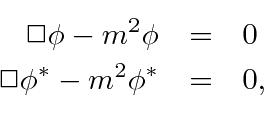Next: The Schrödinger-Pauli Hamiltonian Up: Dirac Equation Previous: Dirac Equation Contents


Because the Schrödinger equation is first order in the time derivative,
the initial conditions needed to determine a solution to the equation are just
 .
In an equation that is second order in the time derivative, we also need to specify
some information about the time derivatives at
.
In an equation that is second order in the time derivative, we also need to specify
some information about the time derivatives at
![]() to determine the solution at a later time.
It seemed strange to give up the concept that all information is contained in the wave function
to go to the relativistically correct equation.
to determine the solution at a later time.
It seemed strange to give up the concept that all information is contained in the wave function
to go to the relativistically correct equation.
If we have a complex scalar field that satisfies the (Euler-Lagrange = Klein-Gordon) equations



The perceived problem with this probability is that it is not always positive.
Because the energy operator appears squared in the equation, both positive energies and negative energies are solutions.
Both solutions are needed to form a complete set.
With negative energies, the probability density is negative.
Dirac thought this was a problem.
Later, the vector
![]() was reinterpreted as the electric current and charge density,
rather than probability.
The Klein-Gordon equation was indicating that particles of both positive and negative charge are present in the complex
scalar field.
The ``negative energy solutions'' are needed to form a complete set, so they cannot be discarded.
was reinterpreted as the electric current and charge density,
rather than probability.
The Klein-Gordon equation was indicating that particles of both positive and negative charge are present in the complex
scalar field.
The ``negative energy solutions'' are needed to form a complete set, so they cannot be discarded.
Dirac sought to solve the perceived problem by finding an equation that was somehow linear in the time derivative as is the Schrödinger equation. He managed to do this but still found ``negative energy solutions'' which he eventually interpreted to predict antimatter. We may also be motivated to naturally describe particles with spin one-half.
Jim Branson 2013-04-22